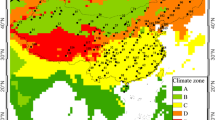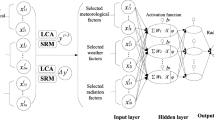Abstract
This study attempts to find statistical methods of predicting infrared visibility (IRV), as calculated from hourly meteorological observations from a North Atlantic weather ship. Simple and multiple regressions expressing IRV as a function of its component weather variables, and exponential data transformations, for time lags of 1 to 24 hours, gaveR 2 values from 0.68 (1-hour lag) to 0.09 (24-hour lag). These have limited predictive power for lags up to 6 hours, almost none for longer lags. Two-category discriminant analysis, using class breaks at 2 km or 10 km is of little use, due to uneven data distribution.
Possibly more promising would be an application of Machine Output Statistics (‘MOS’), used routinely for temperature forecasts, to this problem.
Similar content being viewed by others
References
Johnston, R. J.,Multivariate Statistical Analysis in Geography (Longman, New York 1978), p. 243.
Katz, B. S., Hepfer, K., andMac Meekin, N.,Electro-Optical Meterological Sensitivity Study (Naval Surface Weapons Center (White Oak, MD 1979), PR 79-67.
Tatsuoka, M. M.,Multivariate Analysis (Wiley, New York 1971).
Author information
Authors and Affiliations
Rights and permissions
About this article
Cite this article
Court, A., Lin, GY. & Zetsche, S. Infrared visibility prediction by statistical methods. PAGEOPH 120, 203–210 (1982). https://doi.org/10.1007/BF00877031
Received:
Revised:
Issue Date:
DOI: https://doi.org/10.1007/BF00877031




